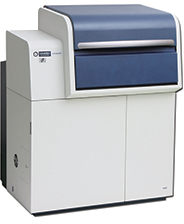
Ratio Beam Spectrophotometer
U-4150

The U4150 is a research grade UV Vis NIR spectrophotometer for the measurement of solids and liquids in transmission and reflection modes.
The system comes with an integrating sphere as standard and features traditional double beam technology, variable band pass and patented detector change software.
A wide range of measurement accessories is also available
Multiple detectors are installed in the integrating sphere to perform measurement over a wide range of wavelengths, from ultraviolet to visible to near infrared regions. The changes in photometric values at detector switching (from signal level differences) are minimized due to a design utilizing Hitachi???s expertise in integrating sphere construction, signal processing technologies, etc.

Example of Measured Data around the Wavelength of Detector Switching (Absorption spectrum of Gold Nanorods)
The UH4150 adopts a prism-grating (P-G) double monochromator optical system, continuing the established reputation of the U-4100 optical system. Large changes in light intensity of the S and P polarization are less likely for the prism-grating (P-G) system than for the generally used grating-grating (G-G) system. The UH4150 offers low noise measurements, even for low transmittance and reflectance samples.
The incident angle is important for the measurement of specular reflectance of solid samples. For focused light beam, the incident angle varies depending on the lens???s focal length, etc. Consequently, the values of simulation of design of optical thin films, such as dielectric multilayer film and prism, would differ from actual measured values. In the case of a collimated light beam, however, the incident angle is always the same with respect to the sample, leading to a highly accurate measurement of specular reflectance. Moreover, the collimated light beam is useful for the evaluation of diffusivity (haze) and the measurement of transmittance of lenses.

Specular Reflectance measurement example
Eight types of integrating spheres of different materials, sizes, and shapes are available

Lineup of Detectors
The door of sample compartment is modified to improve the operation. An ergonomic design is adopted by taking into account the operation of replacing samples and accessories.
Compatible with many of the U-4100 accessories.
Common accessories are available for both models. Accessories used with Model U-4100 can also be used with Model U4150. Since the accessories are removable, they help to accommodate a wider range of measurement types.
Higher throughput than Model U-4100.
While maintaining the high-performing optical system of the model U-4100, the UH4150 provides higher throughput measurements. In the previous model, a scan speed of 600 mm/min was necessary for a measurement using a data interval of 1 nm. With Model UH4150, you can measure at 1 nm intervals while using a scan speed of 1,200 nm/min, reducing the measurement time significantly.*5 The UH4150 measures from 240 to 2,600 nm in approximately two minutes. It is effective for samples requiring measurement in UV-VIS-NIR wavelength range, such as Solar Reflective Materials.

Reflectance Spectrum of Solar Reflective Material using Scan Speed of 600 nm/min

Reflectance Spectrum of Solar Reflective material using Scan Speed of 1,200 nm/min
SPECIFICATIONS
| ITEM | Integrating sphere detection system | Direct light detection system | |
|---|---|---|---|
| Detector Photomultiplier (UV-VIS) and Cooled PbS detector (NIR) | Standard Integrating Sphere (inner coating: BaSO4) 60 mm Standard Integrating Sphere (4-port type) : Incident angle on reflective sample: Sample side: 8°, reference side: 0° 60 mm Standard Integrating Sphere (4-port type) : Incident angle on reflective sample: Sample side and reference side; 10° 60 mm Standard Full Integrating Sphere (2-port type) | High-sensitivity integrating sphere (inner coating: Spectralon®) Direct light detector 60 mm High-sensitivity Integrating Sphere (4-port type): Incident angle on reflective sample: Sample side: 8°, reference side: 0° 60 mm High-sensitivity Full Integrating Sphere (2-port type) | Diffraction grating-diffraction grating Double monochromator Seya-Namioka mount |
| Setting wavelength range | 175 - 3,300 nm | ||
| Monochromator | Prism-Grating, Double monochromator, Pre-monochromator: Littrow monochromator using a prism, Main monochromator: Czerny-Turner monochromator using Diffraction grating (2 switchable diffraction gratings) | ||
| Data processing unit | PC: OS; Windows® 7 Professional (32 bit or 64 bit) | ||
| Operating temperature | 15 - 35°C | ||
| Operating humidity | 25 - 80% (No condensing, 70% or less under temperatures of 30°C or higher) | ||
| Physical size, Weight | 900 (W) ?? 760 (D) ?? 1,180 (H) mm 160 kg | ||